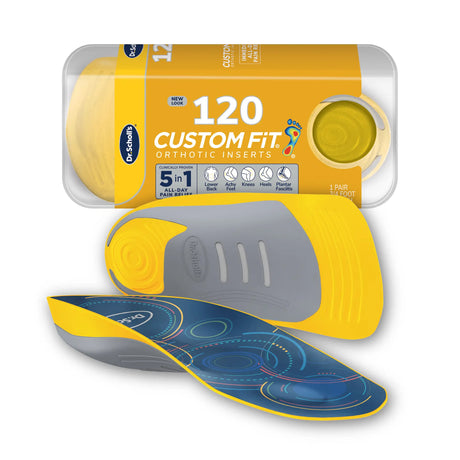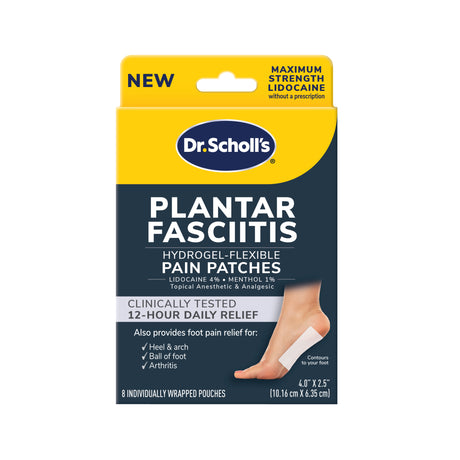Plantar Fasciitis Pain FAQs
Economy shipping is FREE for orders over $25+!

Plantar fasciitis is inflammation at the site where the plantar fascia, a long ligament that runs along the bottom of the foot just below the skin, attaches to the heel bone. This thin strong fibrous ligament attaches the heel bone to the toes. The plantar fascia supports the arch of the foot when standing and engaging in any type of activity that involves putting pressure on the foot, such as walking and running.
When the plantar fascia experiences inflammation at the point of attachment, pain can occur. The pain from plantar fasciitis is usually concentrated in or around the heel. In fact, plantar fasciitis is one of the most common reasons for heel pain. Most often, the discomfort develops over time and increases in intensity little by little. However, the true sign of plantar fasciitis is a very acute pain in the heel upon rising from bed in the morning.
The pain may then improve with increased activity during the day, but then it may return when you first stand after sitting or lying down for a considerable length of time. Pain may also worsen following a lengthy period of intense exercise where the feet are heavily impacted.
Plantar fasciitis falls into a category of injuries referred to as overuse Injuries. The risk of plantar fasciitis increases with physical activity, especially when the activity occurs suddenly. The risk also greatly increases when there’s movement over hard and uneven terrain. A number of factors can contribute to the development of plantar fasciitis, including:
Physical activity – Athletic activities that exert force and pressure on the foot can lead to plantar fasciitis. The condition is most commonly associated with high-impact sports that involve running and jumping.
Improper footwear – Wearing the wrong type of shoe during physical activity can contribute to plantar fasciitis. Improper shoes lack good arch support and cushioning. This can leave the feet vulnerable and unprotected against forceful impact.
Excess body weight – When someone is carrying too much weight, the feet are forced to absorb additional shock. This can play a role in the development of plantar fasciitis.
Overpronation – When the natural movement of pronation is exaggerated during walking and running, the plantar fascia can become overstretched, possibly leading to pain and inflammation.
Abnormal foot structure – Arches that are high or flat can alter body alignment, potentially putting additional stress on the plantar fascia.
Hard surfaces – Standing, walking or running on hard surfaces can increase the risk of plantar fasciitis.
You can help prevent pain from plantar fasciitis in a number of ways.
• Limit the number of days and the amount of time you spend participating in high-impact activities in order to avoid excess stress on the feet. Take breaks in between high-impact workouts by incorporating days of rest into your routine or choosing a low-impact activity in between days of high-impact activity.
• Avoid walking barefoot on hard surfaces.
• Wear shoes with good arch support and cushioning. Choose shoes specifically designed for your intended activity.
• Consider wearing a night splint in order to prevent pain when standing first thing in the morning. Night splints keep the foot slightly flexed while gently stretching the plantar fascia.
• Before working out, consider taping your foot in order to limit the stretching and movement that can lead to plantar fasciitis pain. Be sure to use rigid athletic tape that offers a little bit of stretch.
• Use orthotics or inserts in your shoes for added support and shock absorption. There are a number of effective options.
Since plantar fasciitis is a common problem among runners, Dr. Scholl’s® Performance Sized to Fit Running Insoles were designed to provide superior support and cushioning just for runners. The insoles reduce impact on the feet, minimizing the risk of pain from plantar fasciitis.
Dr. Scholl’s® Plantar Fasciitis Pain Relief Sized to Fit Insoles are specially designed for those with plantar fasciitis. The insoles feature targeted arch support in order to absorb shock and reduce overstretching of the plantar fascia. Wear these insoles daily in order to prevent plantar fasciitis pain from returning.
You can get over-the-counter orthotics made just for you with Dr. Scholl’s® Custom Fit® Orthotics. Step on a Custom Fit® Kiosk for tailor-made orthotics catered to your foot size and arch as well as your weight and pressure points.
There are a number of ways to relieve plantar fasciitis pain. Doctors usually recommend conservative at-home remedies as a first step in reducing pain. These include:
• Rest — You may need to give your foot a chance to heal by avoiding high-impact exercise for a period of time. Consider low-impact athletic activities such as swimming and cycling until your pain resolves.
• Ice — Cold therapy can help ease the inflammation that causes pain. You can apply ice to the bottom of the foot three or four times a day for 15 to 20 minutes at a time. Cover your foot with a sock or thin layer of fabric when icing to protect the skin.
• OTC NSAIDs — Over-the-counter non-steroidal anti-inflammatory drugs such as aspirin, ibuprofen and naproxen can help relieve both pain and inflammation associated with plantar fasciitis.
• Stretching exercises — A physical therapist can recommend a number of different stretching exercises to help relieve discomfort from plantar fasciitis.
See your doctor if you don’t get relief from plantar fasciitis pain after trying at-home remedies. You may require stronger treatments, including:
• Prescription medications – When over-the-counter NSAIDs aren’t effective, your doctor may prescribe stronger pain relievers or anti-inflammatory medications.
• Cortisone shots – A doctor can administer steroid injections in order to reduce inflammation from plantar fasciitis.
• Surgery – In rare cases of severe plantar fasciitis, surgery may be recommended.
Recovering from plantar fasciitis requires patience. It can take months to a year for the plantar fascia to heal. Healing time will vary depending on severity, mitigating efforts and individual health factors. Ask your doctor if you have concerns or questions.





















